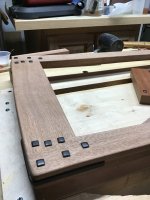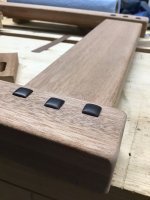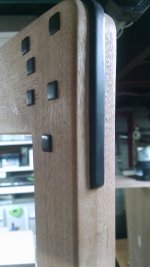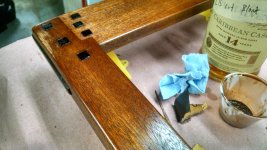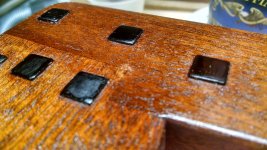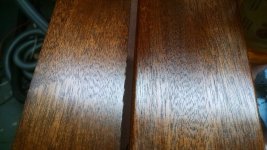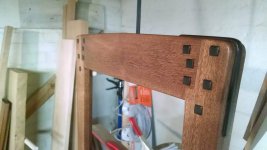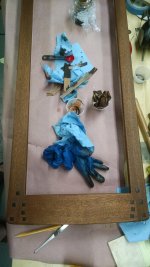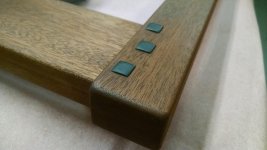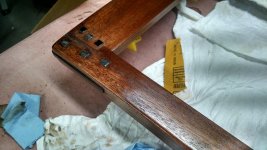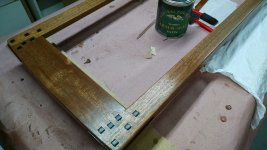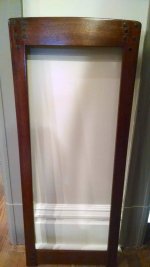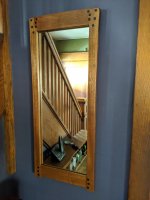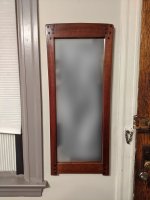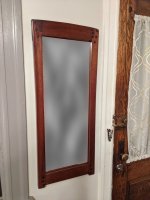I'm building a couple of mirrors that closely imitate the style of the Greene + Greene Blacker house mirror. One is a birthday gift for my mother, although it's going to be about 1/3 of a year late.. the other will be for me to hang on to.
https://collections.lacma.org/node/246347
I thought I would record some of the process here. Because of constraints, I'm building them from laminated 4/4 Sapele instead of 6/4 (the yard only had 4/4 and 8/4. I didn't want to take .75" off the boards by hand and my bandsaw is tiny and limited). Most of the joinery is by hand using chisels saws, and shooting boards.
I'm almost complete with the assembly and should be able to start the finishing process this weekend.
I'm currently at the step of making and installing 3/8" ebony plugs, which are supposed to be pillowed and stand proud of the face of the mirror by a little bit. According to Darrell Peart, the original spec was 1/64" - pretty subtle.
Thus far, mine have come out considerably chunkier and more pronounced.
View attachment 1
View attachment 2
While not consistent w/ Greene and Greene, I'm not sure if it's aesthetically problematic. The issue I have run into is in my understanding of what a pillowed face should properly look like. I've been through several iterations:
1. Twirling on sandpaper w/ a soft backer - slow and inconsistent
2. Hand drill on sandpper w/ Soft Backer (William Ng has a great video on this) - pretty good but my drills don't quite accomodate the oversided 3/8" ebony rod
3. Drill press on sandpaper w/ soft backer - easy but the perfect rotation leaves a concentric swirl in the middle w/ a flat spot. Also, it seems to take off more than I want, creating more of a rounded over effect.
4. By hand using the 'pendulum' motion - I thought this was where I landed and it seemed to give a less pronounced pillowing effect, particularly at the corners.
It looked really good until I installed it, at which point even this had too much rounding over at the corners. Because the corners need to stay proud of the face to maintain the shoulder, if they are rounded too much the plug overall has to project out further.
Now I'm working on deciding whether to mess with these or let them be as they are. To tweak them, I could try to sand them a little flatter and then finesse the corners a little bit. The surrounding frame has already been sanded up to 600 and I've raised the grain twice. So there is a risk of creating some scratches unless I mask around them.There's also the possibility that I can't effectively round them in situ like that.
Other option would be to remove the plugs by drilling them out and then chiseling the waste. I don't really like the thought of that for a couple reasons:
1. I'm dimensioning the ebony by hand and it takes a while as i need to make shallow cuts to dodge tearout. It is hard on my plane blades. I would need to mill up some more to .388 inch square. I wish I had a drum sander for things like this!
2. The plugs are oversized so that the Sapele is forced to compress around them to accomodate the harder ebony. This helps a lot with avoiding any gaps. Now that Ive installed them, I would run the risk of gaps or need to mill up slightly bigger plugs.
3. It would be a shame to waste all that ebony.
For the second mirror, I'm going to see what I can do to improve on this. I think that the arc needs to be about half as much on the plugs, now that I see the relationship between the degree of pillowing and the projection of the plug overall.
https://collections.lacma.org/node/246347
I thought I would record some of the process here. Because of constraints, I'm building them from laminated 4/4 Sapele instead of 6/4 (the yard only had 4/4 and 8/4. I didn't want to take .75" off the boards by hand and my bandsaw is tiny and limited). Most of the joinery is by hand using chisels saws, and shooting boards.
I'm almost complete with the assembly and should be able to start the finishing process this weekend.
I'm currently at the step of making and installing 3/8" ebony plugs, which are supposed to be pillowed and stand proud of the face of the mirror by a little bit. According to Darrell Peart, the original spec was 1/64" - pretty subtle.
Thus far, mine have come out considerably chunkier and more pronounced.
View attachment 1
View attachment 2
While not consistent w/ Greene and Greene, I'm not sure if it's aesthetically problematic. The issue I have run into is in my understanding of what a pillowed face should properly look like. I've been through several iterations:
1. Twirling on sandpaper w/ a soft backer - slow and inconsistent
2. Hand drill on sandpper w/ Soft Backer (William Ng has a great video on this) - pretty good but my drills don't quite accomodate the oversided 3/8" ebony rod
3. Drill press on sandpaper w/ soft backer - easy but the perfect rotation leaves a concentric swirl in the middle w/ a flat spot. Also, it seems to take off more than I want, creating more of a rounded over effect.
4. By hand using the 'pendulum' motion - I thought this was where I landed and it seemed to give a less pronounced pillowing effect, particularly at the corners.
It looked really good until I installed it, at which point even this had too much rounding over at the corners. Because the corners need to stay proud of the face to maintain the shoulder, if they are rounded too much the plug overall has to project out further.
Now I'm working on deciding whether to mess with these or let them be as they are. To tweak them, I could try to sand them a little flatter and then finesse the corners a little bit. The surrounding frame has already been sanded up to 600 and I've raised the grain twice. So there is a risk of creating some scratches unless I mask around them.There's also the possibility that I can't effectively round them in situ like that.
Other option would be to remove the plugs by drilling them out and then chiseling the waste. I don't really like the thought of that for a couple reasons:
1. I'm dimensioning the ebony by hand and it takes a while as i need to make shallow cuts to dodge tearout. It is hard on my plane blades. I would need to mill up some more to .388 inch square. I wish I had a drum sander for things like this!
2. The plugs are oversized so that the Sapele is forced to compress around them to accomodate the harder ebony. This helps a lot with avoiding any gaps. Now that Ive installed them, I would run the risk of gaps or need to mill up slightly bigger plugs.
3. It would be a shame to waste all that ebony.
For the second mirror, I'm going to see what I can do to improve on this. I think that the arc needs to be about half as much on the plugs, now that I see the relationship between the degree of pillowing and the projection of the plug overall.

